F1 2011
[814] 03 February 2011 - 2011 rule changes - shortened shark fins
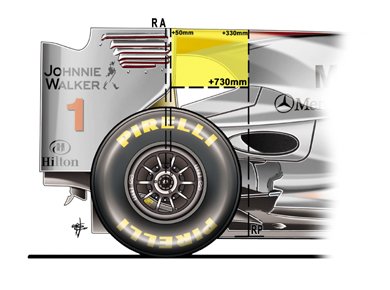 
Teams are no longer able to connect engine cover extensions (commonly known as 'shark fins') to the rear wing. This is related to the ban on F-ducts - in 2010 many designers used the connection to form an airflow channel for the duct. It's possible some teams may persevere with reduced shark fins, which also give some benefit in terms of stabilising airflow to the rear wing (as well as providing additional advertising space for sponsors).
FIA Technical Regulation
3.9.1 - No bodywork situated between 50mm and 330mm forward of the rear wheel centre line may be more than 730mm above the reference plane.
[815] 03 February 2011 - 2011 rule changes - ban on double diffusers
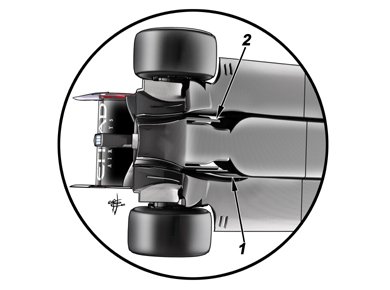 
Brawn GP pioneered the concept to championship-winning effect in 2009, everyone had them in 2010, and now they are outlawed. The 2011 rules make it clear that there must be no gap between reference plane, step plane and diffuser, so no more big holes in the underbody like those seen in this Ferrari image from last season. Single, blown diffusers are still allowed, but regardless, the proportion of downforce generated by the diffuser will be far lower.
FIA Technical Regulation
3.12.9 - In an area lying 450mm or less from the car centre line, and from 450mm forward of the rear face of the cockpit entry template to 350mm rearward of the rear wheel centre line, any intersection of any bodywork visible from beneath the car with a lateral or longitudinal vertical plane should form one continuous line which is visible from beneath the car. When assessing the compliance of bodywork surfaces in this area the aperture referred to in Article 3.12.7 need not be considered.
3.12.10 In an area lying 650mm or less from the car centre line, and from 450mm forward of the rear face of the cockpit entry template to 350mm forward of the rear wheel centre line, any intersection of any bodywork visible from beneath the car with a lateral or longitudinal vertical plane should form one continuous line which is visible from beneath the car.
3.12.11 Compliance with Article 3.12 must be demonstrated with the panels referred to in Articles 15.4.7 and 15.4.8 and all unsprung parts of the car removed.
[816] 03 February 2011 - 2011 rule changes - blade-style roll hoops
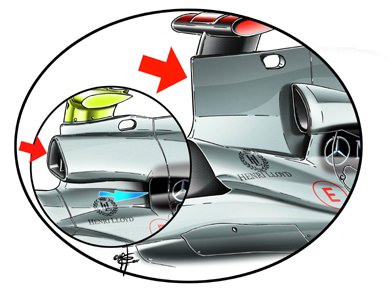 
This blade-style roll hoop design (main drawing) was introduced by Mercedes in 2010 in order to improve airflow to the rear wing. For 2011 the FIA has decided such solutions could prove dangerous in incidents of cars rolling on a soft surface such as grass or sand, where the blade could cut into the ground. A minimum cross section has thus been imposed, to discourage similar designs.
FIA Technical Regulation
15.2.4 - The principal roll structure must have a minimum enclosed structural cross section of 10000mm², in vertical projection, across a horizontal plane 50mm below its highest point. The area thus established must not exceed 200mm in length or width and may not be less than 10000mm2 below this point.
[817] 03 February 2011 - 2011 rule changes - doubled wheel tethers
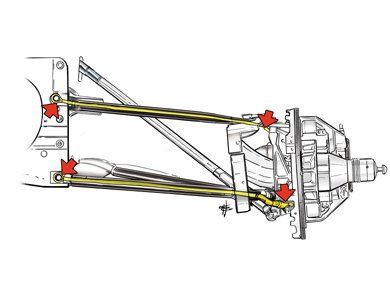 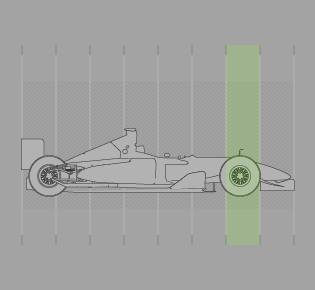
In a bid to further reduce the chances of wheels coming loose - and potentially impacting a driver's head - in the event of an accident, the 2011 regulations require four tethers at each corner of the car, double the 2010 requirement. The tethers are bigger, stiffer, and have to pass a more severe load test.
FIA Technical Regulation
10.3.6 - In order to help prevent a wheel becoming separated in the event of all suspension members connecting it to the car failing provision must be made to accommodate flexible tethers, each with a cross sectional area greater than 110mm². The sole purpose of the tethers is to prevent a wheel becoming separated from the car, they should perform no other function.
The tethers and their attachments must also be designed in order to help prevent a wheel making contact with the driver's head during an accident.
Each wheel must be fitted with two tethers each of which exceed the requirements of 3.1.1 of TestProcedure 03/07.
Each tether must have its own separate attachments at both ends which :
- are able to withstand a tensile force of 70kN in any direction within a cone of 45° (included angle) measured from the load line of the relevant suspension member ;
- on the survival cell or gearbox are separated by at least 100mm measured between the centres of the two attachment points ;
- on each wheel/upright assembly are located on opposite sides of the vertical and horizontal wheel centre lines and are separated by at least 100mm measured between the centres of the two attachment points ;
- are able to accommodate tether end fittings with a minimum inside diameter of 15mm.Furthermore, no suspension member may contain more than one tether.
Each tether must exceed 450mm in length and must utilise end fittings which result in a tether bend radius greater than 7.5mm.
[818] 03 February 2011 - 2011 rule changes - aero rims
 
Rotating wheel discs, or 'wheel-spinners', were banned last year, but teams such as Ferrari effectively circumvented this by casting aero features into the wheel rim itself in a bid to optimise airflow passing through the wheel. There will be far less scope for such concepts in 2011, thanks to tighter restrictions on spoke surface area.
FIA Technical Regulation
12.4.6 - When viewed perpendicular to the plane formed by the outer face of the wheel and between the diameters of 120mm and 270mm the wheel may have an area of no greater than 24,000mm².
[819] 03 February 2011 - 2011 rule changes - starter hole clarification
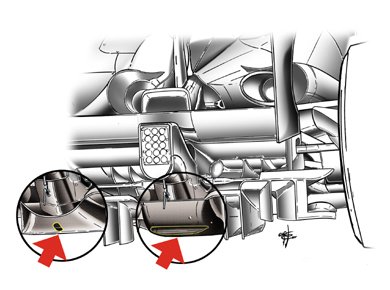 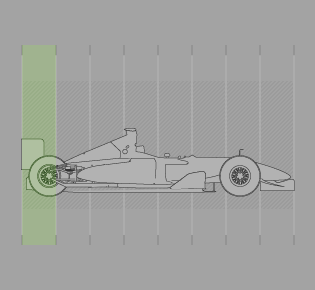
Last year some teams pushed the boundaries of the regulations by introducing unusually-shaped engine starters, thus allowing them to have similarly-shaped starter holes in the diffuser (most commonly a slot), bringing aerodynamic benefit by making the diffuser more efficient. The FIA issued one clarification on this during the 2010 season (the drawing shows McLaren's starter hole pre- and post-clarification), and for 2011 the dimensions of the hole have been even more explicitly defined.
FIA Technical Regulation
3.12.7 - No bodywork which is visible from beneath the car and which lies between the rear wheel centre line and a point 350mm rearward of it may be more than 125mm above the reference plane. With the exception of the aperture described below, any intersection of the surfaces in this area with a lateral or longitudinal vertical plane should form one continuous line which is visible from beneath the car.
An aperture for the purpose of allowing access for the device referred to in Article 5.16 is permitted in this surface. However, no such aperture may have an area greater than 3500mm2 when projected onto the surface itself and no point on the aperture may be more than 100mm from any other point on the aperture.
Additionally, any bodywork in this area must produce uniform, solid, hard, continuous, rigid (no degree of freedom in relation to the body/chassis unit), impervious surfaces under all circumstances).
[820] 03 February 2011 - 2011 rule changes - stricter floor load tests
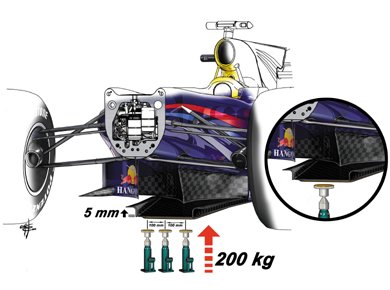 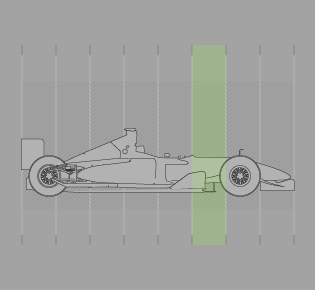
The FIA tightened up on floor load testing at last year's Italian Grand Prix, following the much-talked-about 'flexi-floor' controversy and the stricter tests have been written into the regulations for 2011. The floor is now subject to load at three different points, each 100mm apart, rather than at one central point, with a maximum permitted deflection of 5mm.
FIA Technical Regulation
3.17.5 - Bodywork may deflect no more than 5mm vertically when a 2000N load is applied vertically to it at three different points which lie on the car centre line and 100mm either side of it. Each of these loads will be applied in an upward direction at a point 380mm rearward of the front wheel centre line using a 50mm diameter ram in the two outer locations and a 70mm diameter ram on the car centre line. Stays or structures between the front of the bodywork lying on the reference plane and the survival cell may be present for this test, provided they are completely rigid and have no system or mechanism which allows non-linear deflection during any part of the test.
Furthermore, the bodywork being tested in this area may not include any component which is capable of allowing more than the permitted amount of deflection under the test load (including any linear deflection above the test load), such components could include, but are not limited to :
a) Joints, bearings pivots or any other form of articulation.
b) Dampers, hydraulics or any form of time dependent component or structure.
c) Buckling members or any component or design which may have, or is suspected of having, any non-linear characteristics.
d) Any parts which may systematically or routinely exhibit permanent deformation.
[821] 03 February 2011 - 2011 rule changes - no sprung plank fixings
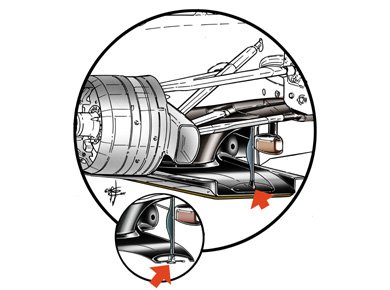 
In combination with the stricter floor load tests, the FIA has also banned the use of any springs, pivots, joints or dampers in the mounting of the plank's vertical stay. This means the plank cannot flex upwards at speed and give the car a lower ride height (thus providing an aerodynamic performance gain).
FIA Technical Regulation
3.17.5 - Bodywork may deflect no more than 5mm vertically when a 2000N load is applied vertically to it at three different points which lie on the car centre line and 100mm either side of it. Each of these loads will be applied in an upward direction at a point 380mm rearward of the front wheel centre line using a 50mm diameter ram in the two outer locations and a 70mm diameter ram on the car centre line. Stays or structures between the front of the bodywork lying on the reference plane and the survival cell may be present for this test, provided they are completely rigid and have no system or mechanism which allows non-linear deflection during any part of the test.
Furthermore, the bodywork being tested in this area may not include any component which is capable of allowing more than the permitted amount of deflection under the test load (including any linear deflection above the test load), such components could include, but are not limited to :
a) Joints, bearings pivots or any other form of articulation.
b) Dampers, hydraulics or any form of time dependent component or structure.
c) Buckling members or any component or design which may have, or is suspected of having, any non-linear characteristics.
d) Any parts which may systematically or routinely exhibit permanent deformation.
[822] 03 February 2011 - 2011 rule changes - restrictions on front chassis height
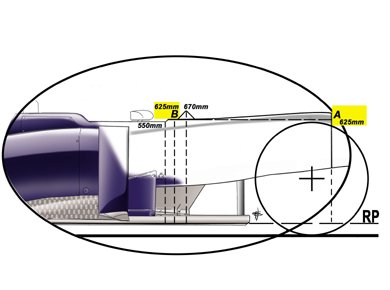 
To kerb increasing heights of the front sections of chassis, the FIA has put new limits in place in order to preserve driver visibility and safety. The section between the vertical lines A and B now has a maximum height of 625mm above the reference plane (RP).
FIA Technical Regulation
From 15.4.4 - The maximum height of the survival cell between the lines A-A and B-B is 625mm above the reference plane.
[823] 03 February 2011 - 2011 rule changes - F-duct ban
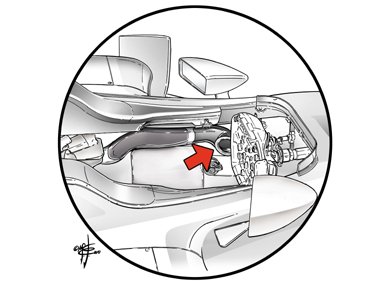 
For 2011 the FIA have specifically outlawed the use of driver movement to control any system that influences the car's aerodynamic characteristics. This means no more F-ducts, where the driver covered a hole in the cockpit to alter the airflow to the rear wing, allowing it to stall and cut drag at high speeds.
FIA Technical Regulation
From 3.15 - Aerodynamic influence - With the exception of the parts necessary for the adjustment described in Article 3.18, any car system, device or procedure which uses, or is suspected of using, driver movement as a means of altering the aerodynamic characteristics of the car is prohibited.
[824] 03 February 2011 - 2011 rule changes - adjustable rear wing
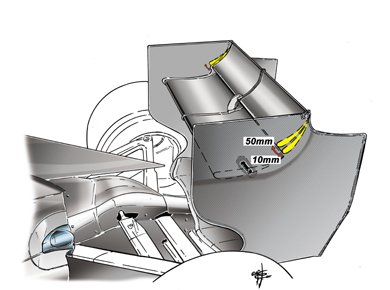 
This change is designed to increase the amount of overtaking. The driver-adjustable front wing of 2010 is gone, replaced by a driver-adjustable - but FIA regulated - rear wing. It has just two settings, ON and OFF effectively, with the ON setting increasing the gap between the main plane and the flap from 10-15mm to 50mm. This will reduce drag significantly and so improve top speed. Drivers can use the system at any time in practice and qualifying, but in the race there are restrictions. It cannot be used in the opening two laps, and then will only be made available to the driver at set points on the circuit if he is less than one second behind the car ahead. A dashboard light will notify him when the system is enabled. The system is deactivated when the driver releases the button or brakes.
FIA Technical Regulation
3.18 - Driver adjustable bodywork :
3.18.1 The incidence of the rearmost and uppermost closed section described in Article 3.10.2 may be varied whilst the car is in motion provided :
- It comprises only one component that must be symmetrically arranged about the car centre line with a minimum width of 708mm.
- With the exception of minimal parts solely associated with adjustment of the section, no parts of the section in contact with the external airstream may be located any more than 355mm from of the car centre line.
- With the exception of any minimal parts solely associated with adjustment of the rearmost and uppermost section, two closed sections are used in the area described in Article 3.10.2.
- Any such variation of incidence maintains compliance with all of the bodywork regulations.
- When viewed from the side of the car at any longitudinal vertical cross section, the physical point of rotation of the rearmost and uppermost closed section must be fixed and located no more than20mm below the upper extremity and no more than 20mm forward of the rear extremity of the area described in Article 3.10.2 at all times.
- The design is such that failure of the system will result in the uppermost closed section returning to the normal high incidence position.
- Any alteration of the incidence of the uppermost closed section may only be commanded by direct driver input and controlled using the control electronics specified in Article 8.2.
3.18.2 The adjustable bodywork may be activated by the driver at any time prior to the start of the race and, for the sole purpose of improving overtaking opportunities during the race, after the driver has completed a minimum of two laps after the race start or following a safety car period.
The driver may only activate the adjustable bodywork in the race when he has been notified via the control electronics (see Article 8.2) that it is enabled. It will only be enabled if the driver is less than one second behind another at any of the pre-determined positions around each circuit. The system will be disabled by the control electronics the first time the driver uses the brakes after he has activated the system.
The FIA may, after consulting all competitors, adjust the above time proximity in order to ensure the stated purpose of the adjustable bodywork is met.
[825] 03 February 2011 - 2011 rule changes - restrictions on rear crash structure
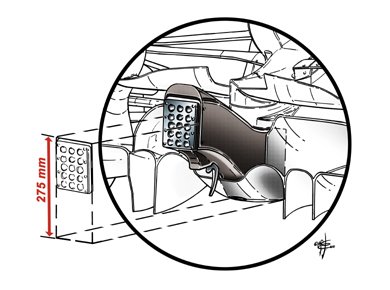 
To stop teams sculpting the shape of the deformable rear crash structure for aerodynamic gain (as per the example in the main drawing), the FIA have more strictly defined its height and positioning (dotted lines).
FIA Technical Regulation
From 15.5.3 - Furthermore, when viewed from the side, the lowest and highest points of the impact absorbing structure between its rear face and 50mm aft of the rear wheel centre line may not be separated vertically by more than 275 mm.
[826] 03 February 2011 - 2011 rule changes - rear wing simplification
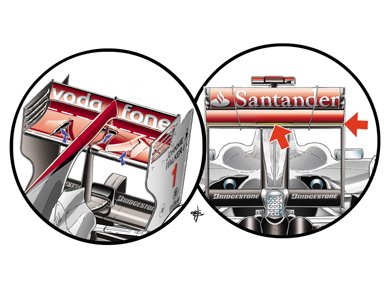 
Teams are no longer allowed slots in the rear wing's main plane outside of the central 15cm area, and the rear wing may have no more than two sections (main plane and flap). This is to stop the use of main plains with 'sections within sections', such as that introduced by McLaren at Monaco in 2009 and subsequently used by Williams and BMW Sauber (2009), Red Bull, Mercedes, Renault and Toro Rosso (2010). The same restriction applies to the lower beam wing used by Williams last season from Monaco onwards.
FIA Technical Regulation
3.10.2 - Other than the bodywork defined in Article 3.10.9, any bodywork behind a point lying 50mm forward of the rear wheel centre line which is more than 730mm above the reference plane, and less than 355mm from the car centre line, must lie in an area when viewed from the side of the car that is situated between the rear wheel centre line and a point 350mm behind it.
With the exception of minimal parts solely associated with adjustment of the section in accordance with Article 3.18 :
- when viewed from the side of the car, no longitudinal cross section may have more than two sections in this area, each of which must be closed.
- no part of these longitudinal cross sections in contact with the external air stream may have a local concave radius of curvature smaller than 100mm.
Once the rearmost and uppermost section is defined, 'gurney' type trim tabs may be fitted to the trailing edge. When measured in any longitudinal cross section no dimension of any such trim tab may exceed 20mm.
The chord of the rearmost and uppermost closed section must always be smaller than the chord of the lowermost section at the same lateral station.
Furthermore, the distance between adjacent sections at any longitudinal plane must lie between 10mm and 15mm at their closest position, except, in accordance with Article 3.18, when this distance must lie between 10mm and 50mm.
[827] 03 February 2011 - 2011 rule changes - rear-view mirror placement
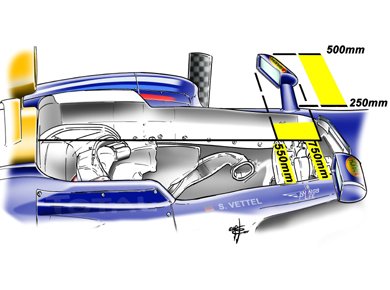 
Ahead of last year's Spanish Grand Prix, the teams agreed to change the placement of rear-view mirrors for safety reasons and this has now been set in stone in the regulations. Previously, teams had started to position mirrors to boost aero efficiency, with the driver's rearward vision becoming an increasingly secondary consideration. Mirrors must now be 'inboard', where they can be of most benefit to the drivers.
FIA Technical Regulation
14.3.3 - All parts of the rear view mirrors, including their housings and mountings, must be situated between 250mm and 500mm from the car centre line and between 550mm and 750mm from the rear edge of the cockpit entry template.
[828] 03 February 2011 - 2011 rule changes - fixed weight distribution
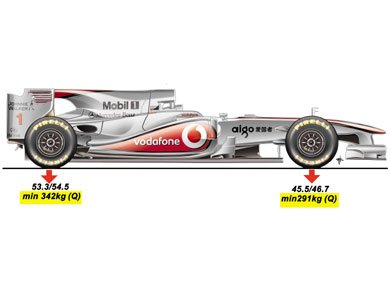 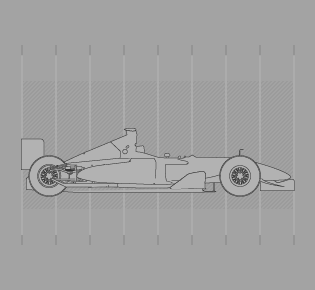
To coincide with the introduction of Pirelli tyres, the FIA have imposed a mandatory weight distribution range for 2011. The standardised distribution of 45.5-46.7 percent front, 53.3-54.5 rear will ensure one team alone doesn't strike lucky and stumble upon the perfect set-up for the as-yet-unknown Pirelli rubber (thus potentially prompting others into costly wheelbase changes). During the qualifying session a car on dry tyres can't weigh less than 342kg at the back and 291kg at the front.
FIA Technical Regulation
4.2 - For 2011 only, the weight applied on the front and rear wheels must not be less than 291kg and 342kg respectively at all times during the qualifying practice session. If, when required for checking, a car is not already fitted with dry-weather tyres, it will be weighed on a set of dry-weather tyres selected by the FIA technical delegate.
[829] 09 February 2011 - Ferrari F10/F150th Italia - overhead comparison
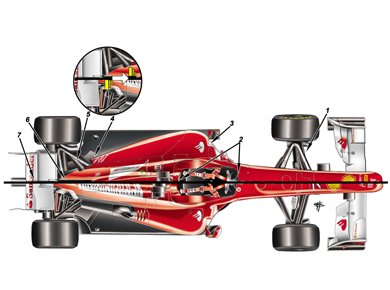 
Although the chassis is higher and the nose flatter on the F150 (top), the new car's front wing is the final iteration from last season's F10 (bottom). The new front suspension (1) has higher wishbones and, for the first time on a Ferrari, the steering arm is not inside the top wishbone. To improve visibility and gain some more room for the fuel tank, the driver is seated more vertically in the cockpit (2). The sidepods (3) have improved intrusion protection and inlets shaped in a similar style to those on last season's McLaren. The rear, 'cola bottle' section of the car is much wider, with the exhausts - which will undergo further changes ahead of the season - sited in a very low position (4). Although Ferrari have opted to retain their push-rod suspension (5) for 2011, by reducing the gearbox size and moving the damper and rocker installation forward by 15cm (inset) they can derive similar benefits to those gleaned from a pull-rod suspension system, with very compact packaging. The area in front of the rear wing and diffuser (6) has been neatened and narrowed to improve the flow of air. The rear wing and diffuser themselves are just temporary solutions so the team can run the car and test its reliability. Updated versions will be installed before the first race.
[830] 09 February 2011 - Ferrari F150th Italia - rear suspension
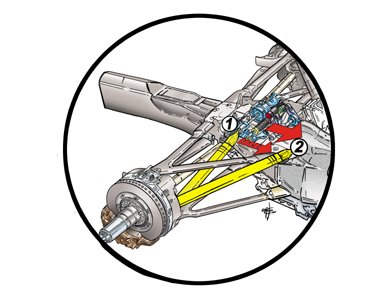 
Ferrari have retained their push-rod suspension, but have moved its elements forward. The larger angle of the push-rod link (1 and 2, highlighted in yellow) means the car can have a very narrow and low rear section.
[831] 09 February 2011 - Ferrari F150th Italia - 2010/2011 front suspension comparison
 
With the chassis positioned five centimetres higher, the suspension pick-up points are also higher (main drawing - 2011; inset - 2010). And in a first for Ferrari, the steering arm is no longer included inside the top wishbone (red arrow).
[832] 11 February 2011 - Renault R31 - forward exhausts
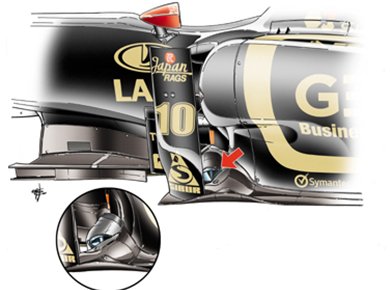 
Renault are no strangers to radical exhaust solutions, having launched a design that blew on to the diffuser with the RE30 at Monaco in 1983, and side-exit exhausts on the RE50 in 1985. This season the exits are low down, just in front of the sidepods, in order to accelerate the airflow to the rear diffuser. They are angled backwards slightly, with a very long pipe length designed to minimise the torque and power handicap that comes with the unusual positioning.
[833] 11 February 2011 - McLaren MP4-26 - L-shaped sidepods
 
There is no doubting the new MP4-26 is very different from all the other 2011 cars. Technical director Paddy Lowe has exploited to the extreme the idea of higher outer sidepods, last seen on the likes of Benetton's B195 from 1995 and Ferrari's F310 from 1996. The aim is to clean up and better direct the airflow to the beam wing at the rear of the car, an area now even more important thanks to the ban on double diffusers. This solution also gives McLaren the possibility of running Renault-style forward exhaust exits.
[834] 11 February 2011 - Red Bull RB7 - revised exhausts
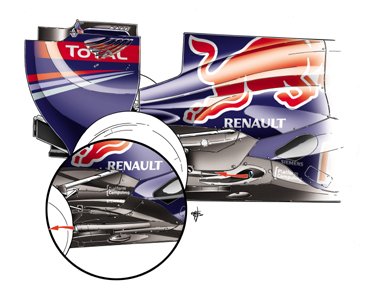 
Red Bull rolled out the RB7 at Valencia and by the end of the test had already added a new solution to the new car. Longer exhaust pipes (inset), blowing on to the external section of the diffuser's side channel, replaced the standard design seen on the first day.
[835] 11 February 2011 - Toro Rosso STR6 - double floor arrangement
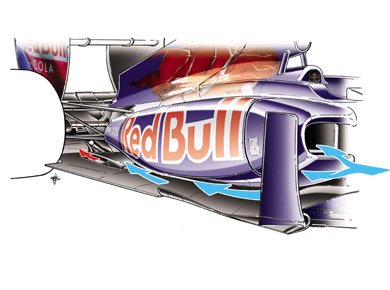 
In a solution not dissimilar to that seen on 1992's Ferrari F92, Toro Rosso's 2011 car has raised sidepods to create a second venture channel in order to achieve extra downforce. This is combined with quite long exhausts, with flat exhaust exits (red arrow) towards the rear of the car.
[836] 14 February 2011 - Ferrari F150th Italia - oil tank changes
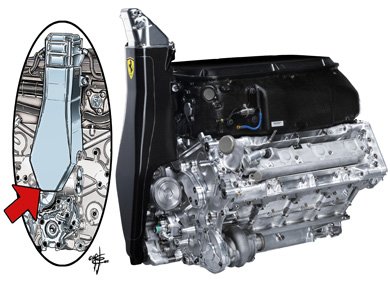 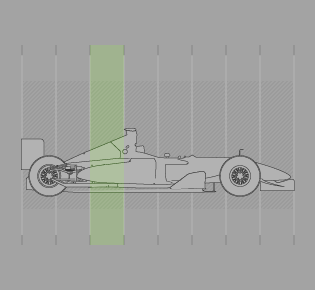
The F150th Italia has almost the same wheelbase as 2010's F10, even though the team's KERS system has been positioned inside the car's fuel tank area. In addition, the oil tank has more capacity (see photograph), and is much taller than the one used in the 2009 F60 (see drawing, red arrow).
[837] 15 February 2011 - Williams FW33 - innovative rear packaging
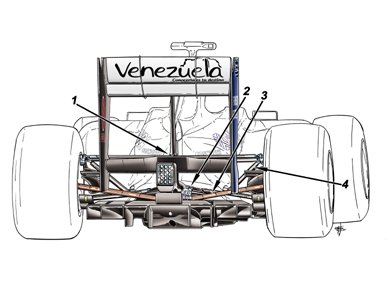 
The Williams FW33 has the lowest rear end (2) of all the new cars - lower even than Red Bull's RB7 - due to very compact packaging of the gearbox and differential. So low are they in fact that the driveshaft (3) angle is the greatest ever seen, at around 14° (6-7° is normally considered the maximum limit for this component). Williams spent a lot of time developing and testing this solution before introducing it to the new project. Indeed, the whole rear of the FW33 is innovative - witness the unique pick-up point for the suspension's top wishbone, mounted directly on the central rear wing pillar (1). Williams have also followed the trend for a pull rod rear suspension layout (4) for 2011. Only Ferrari, Sauber (with the Ferrari gearbox), Virgin and HRT have kept a push-rod layout.
[838] 23 February 2011 - Red Bull RB7 - exhaust positioning
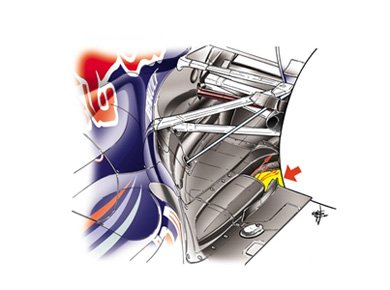 
At the very first test in Valencia Red Bull introduced a new blown exhaust layout. The long flat pipe blows into the area just in front of the rear tyres (see red arrows). In this section (highlighted in yellow) the underbody has been cut away so that the air can blow directly under the side channels of the diffuser. This solution appeared to have been copied by Force India at the most recent test at Barcelona's Circuit de Catalunya.
[839] 25 February 2011 - McLaren MP4-26 - exhaust positioning
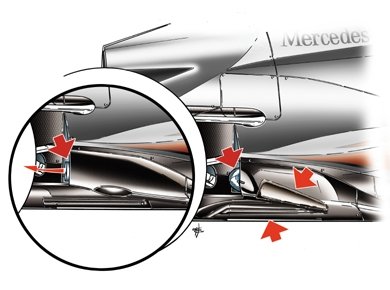 
Although McLaren haven't opted to use forward-facing exhausts, the team have come up with two different exhaust solutions at the back. One is very traditional (inset) and blows directly towards the rear of the car. The second is much more complex (main image) and features a U-bend pipe, with a bonded section on the side of the car's stepped bottom. This hides the flat and wide exhaust exit, which blows towards the starter hole in the centre of the rear diffuser.
[840] 07 March 2011 - Ferrari 150° Italia - exhaust positioning
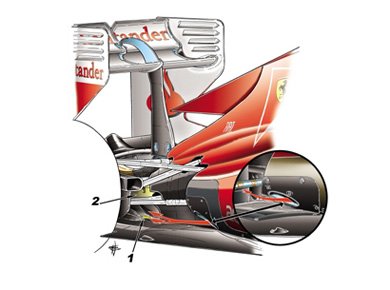 
The exhausts on the Ferrari are very low and flat (inset). They blow towards a channel (1) that exits through a thin horizontal window, which is the car's starter hole. The rules limit the size of the starter hole to a maximum surface area of 3,500mm². The centralised nature of the exhaust's positioning has forced the Italian team to add heat protection around the car's deformable rear crash structure (2).
[841] 21 March 2011 - Mercedes MGP W02 - final testing updates
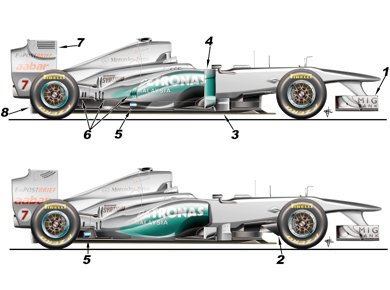 
Following its lacklustre showing in early tests, Mercedes' 2011 car looked far more promising after it was extensively modified for the final Barcelona session, with the team becoming the first to follow Renault's forward exhaust solution, albeit in less extreme form. This drawing shows the original car (bottom) and the modified version (top). Mercedes trialled three different front wings (1), including a double-flap extension to the double-decker flaps, and a blown main plane. The angled fins (2) inside and behind the front wheels have been removed and the turning vanes (3) and sidepods (4) have been revised. The exhaust exits (5) are now in a new bodywork assembly in the middle of the sidepods - previously they were in a standard position at the rear. There are additional gills (6) in the bodywork to improve cooling and a new rear wing (7). The rear diffuser (8) has been updated, with its middle plates in revised positions.
[842] 27 March 2011 - Red Bull RB7 - revised blown exhausts
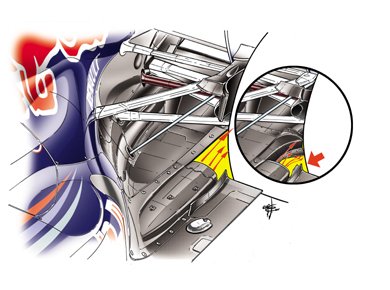 
For Australia Red Bull have slightly modified their blown exhausts, with a small extension on the flat pipe blowing just in front of the rear tyres (main drawing - previous design inset). The underbody has been cut slightly differently (highlighted in yellow) in order to divert more airflow under the side channels of the rear diffuser.
[843] 27 March 2011 - Ferrari 150° Italia - pre-season evolution
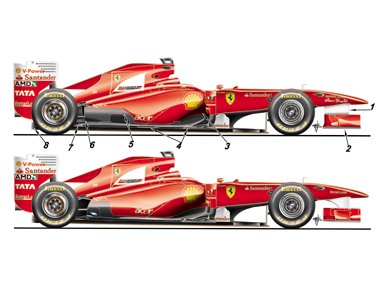 
After a hectic winter test programme, Ferrari have introduced the latest version of their 2011 car (top drawing - launch version below) for the Australian Grand Prix. There are new front wing supports (1), featuring very wide pillars, in order to better channel the air under the car, whilst the revised front wing has noticeably different endplates (2). There is a much bigger undercut (3) at the front of the sidepods to feed more air to the back of the car. At the car's midpoint there are new vertical splitters (4), whilst narrower bodywork is highlighted by the larger portion of the black, heat-resistant material (5). There's a revised exhaust (6), inspired by the one featured on the Red Bull, which features longer pipes blowing towards the side diffusers (7). Finally at the back there's a new version of the diffuser designed to complement the revised exhausts (8).
[844] 27 March 2011 - Williams FW33 - innovative gearbox layout
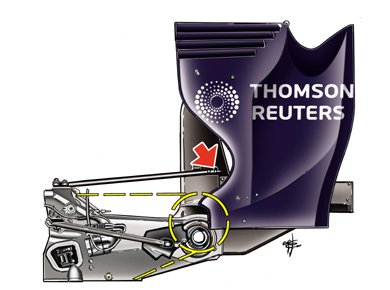 
Arguably the most innovative solution on the 2011 Williams is the layout of its new gearbox, which has been designed to match the car's new rear aero package, in light of this year's ban on the double diffusers. The gearbox's vertical dimensions have been dramatically cut and the differential has been lowered (see yellow highlighted area). This forced the team, after a great deal of research, to choose an extreme driveshaft angle of nearly 16 degrees, which is very unusual, as is attaching the suspension's top wishbone to the rear wing support (red arrow). This solution could be very advantageous, although there are still limits, mostly imposed by the dimensions of the car's engine cover.
[845] 27 March 2011 - McLaren MP4-26 - revised exhaust layout
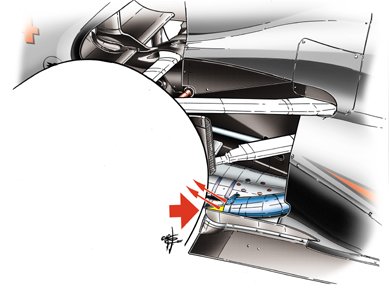  Both Ferrari and McLaren have followed Red Bull in the layout of their exhaust systems, but while the Scuderia had theirs on the car at the last Barcelona test, complete with new sidepods and aero package, the Woking team only prepared their new pieces in time for Australian Grand Prix. The exhausts are longer and blow into a cut-out outside section of the diffuser (as on the Red Bull). Another change is that the diffuser is now made in titanium (highly resistant to heat), using a quick prototyping technique.
Both Ferrari and McLaren have followed Red Bull in the layout of their exhaust systems, but while the Scuderia had theirs on the car at the last Barcelona test, complete with new sidepods and aero package, the Woking team only prepared their new pieces in time for Australian Grand Prix. The exhausts are longer and blow into a cut-out outside section of the diffuser (as on the Red Bull). Another change is that the diffuser is now made in titanium (highly resistant to heat), using a quick prototyping technique.
[846] 09 April 2011 - Stricter front-wing load test
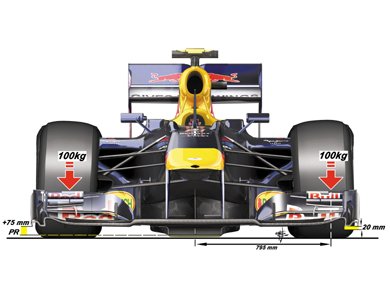 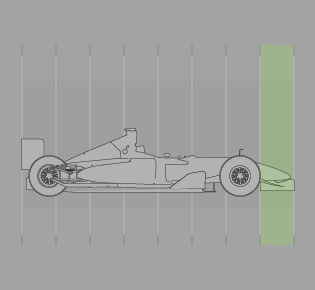
The technical regulations state that a front wing must be no lower than 75mm above the reference plane, which is the lowest point of the car excluding the plank (yellow dotted line). To check compliance with this rule, 100kg loads are applied to the two ends of the front wing (red arrows) in scrutineering, with movement of no more than 20mm allowed. This year the FIA have brought into force a stricter test in which loads are applied either simultaneously or on one side at a time. Despite controversy about their 'flexible' front wing, Red Bull have passed this test, leaving their rivals striving to develop similar solutions.
[847] 09 April 2011 - Ferrari 150° Italia - revised front wing
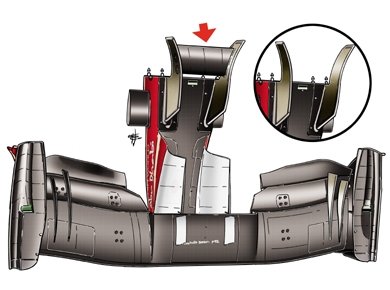 
For Malaysia, Ferrari have modified their car's front wing slightly, with the addition of this small flap (red arrow) between the turning vanes. The team have also made some very subtle changes to the endplates. As they attempt to find more pace in the car, Ferrari's drivers have sampled several different front wing configurations during practice and Fernando Alonso was seen to run with a revised second flap. Felipe Massa, meanwhile, was on track on Friday and Saturday morning with an extra camera on the car so that engineers could watch the deflection of the endplates.
[848] 09 April 2011 - Red Bull RB7 - front wing selection
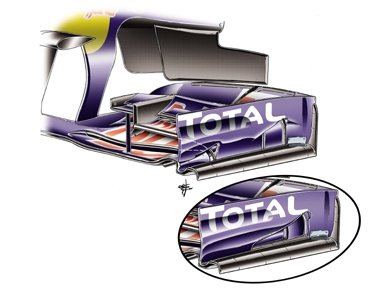 
Red Bull have two front wings available to use in Malaysia, both illustrated here, but both Sebastian Vettel and Mark Webber opted for the inset version with its simpler endplate configuration. Arguably more importantly, however, both drivers also expect to use KERS during both qualifying and in Sunday's race, the team having opted not to run it at the previous round in Australia due to reliability concerns.
[849] 10 April 2011 - Renault R31 - new front wing
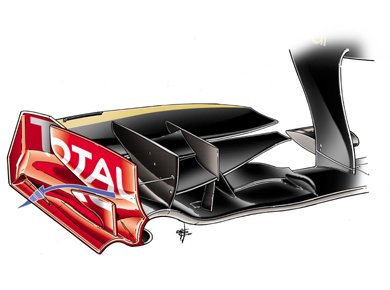 
Renault have brought a new front wing to Malaysia, which features an updated endplate. The small fin on the exterior now has a twisted shape, but there is still a longitudinal hole through which airflow can pass (see blue arrow). After running back-to-back tests on Friday and Saturday morning, both Nick Heidfeld and Vitaly Petrov decided to use the new front wing in qualifying and the race. Petrov also briefly tested a new rear wing, before swapping back to the older version, which the team used in Australia.
[850] 16 April 2011 - Red Bull RB7 - rear diffuser updates
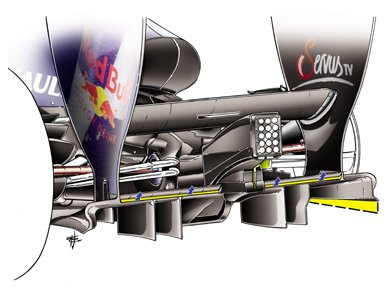 
In China Red Bull have introduced a small change to their diffuser's outer walls, which don't appear to run as close to the ground as you would expect (see yellow area on right) for optimum performance. This is linked to the RB7's unusual set-up, with the back of the car running much higher than that of rival teams' machines. Note also the small flap on top of the diffuser, improving air extraction (blue arrows).
[851] 16 April 2011 - Ferrari 150° Italia - exhaust positioning
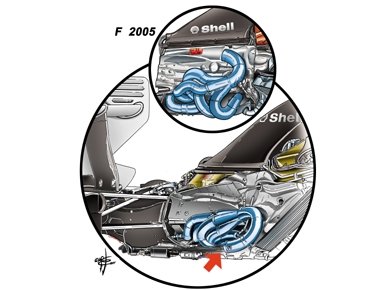 
Most teams this season are using a different exhaust layout to those used last year. The primary pipes are directed forwards (main picture). Ferrari introduced this trend in 2005 (inset), although back then the aim was for the exhaust to blow further forwards. Six years later, the latest layout is designed to free up space within the tightly-packed bodywork and improve the airflow to the rear wing and diffuser.
[852] 16 April 2011 - Williams FW33 - exhaust positioning
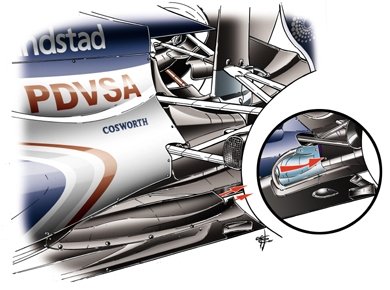 
Williams have brought a new Red Bull-inspired exhaust to China (main picture). To adopt the solution, the British team have had to modify the system's positioning in similar style to that seen on the Ferrari. With just one set of parts available, Rubens Barrichello was chosen to sample it, whilst team mate Pastor Maldonado kept the standard layout (inset) on his car.
[853] 17 April 2011 - Ferrari 150° Italia - new front brake duct
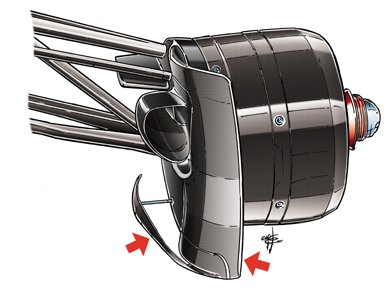 
As well as testing a new front wing on Friday in Shanghai, Ferrari driver Fernando Alonso evaluated a new front brake duct design. Featuring a shroud (right-hand arrow) and a small turning vane (left-hand arrow), the new duct has been designed to better control the flow of air towards the front wing and reduce drag around the tyres. Ferrari (along with Sauber and Toro Rosso) were the only team not using such a solution, which was already seen on most cars last year.
[854] 17 April 2011 - Toro Rosso STR6 - revised exhaust exit
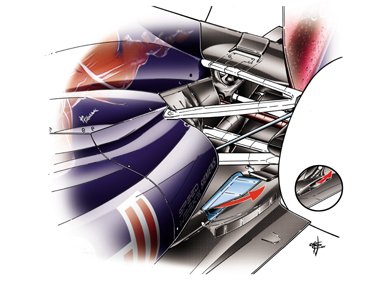 
Toro Rosso brought a modified exit for their exhaust to China. The main change over the older version (inset) is the addition of a horizontal fin at the top (highlighted in blue). After their drivers sampled the new exit during practice, the team removed it from their cars for qualifying and race. Toro Rosso also revised the STR06's brake ducts for the China race in order to improve the flow of air towards the diffuser's side channels.
[855] 07 May 2011 - Toro Rosso STR6 - integrated brake solution
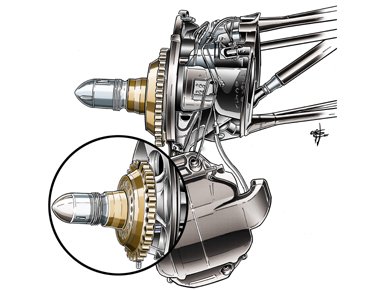 
This is a totally new solution introduced by Toro Rosso in Turkey, with the suspension upright and the fixing bell for the brake disc integrated as a single unit. Usually the bell is separate and then attached to the carbon disc to fix it to the upright (inset). This clever solution saves a little weight and is also stiffer.
[856] 07 May 2011 - Ferrari 150° Italia - new front wing
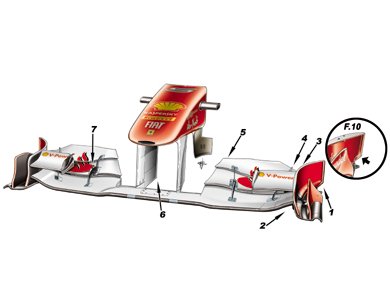 
In Turkey, both Ferrari drivers have been using the new front wing tested only briefly by Fernando Alonso in Shangai. It's different from the previous one in all areas. Totally new is the endplate, with the lower part (1) cut as it was on last year's F10. The main profile is shaped differently in the area beside the endplate (2) and the endplate itself is now thinner and more curved towards the outside (3). The flap is divided into two sections which have different profiles (4 & 5), while the central pillars (6) now converge towards the rear of the nose. Finally there is a new adjustment mechanism (7) for the flap's incidence angle, similar to that used by most other teams.
[857] 08 May 2011 - Mercedes MGP W02 - slotted front wing
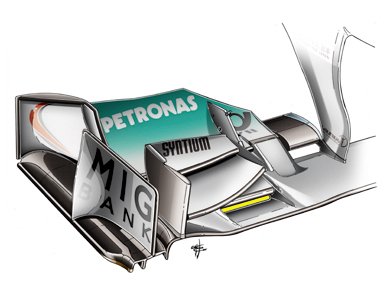 
For the next round in Spain there will be a lot of changes on the Mercedes, with a new cooling system and exhausts. In Istanbul, however, they have again been taking advantage of this front wing, as used in China, with a slot in the main plane (highlighted in yellow). Together with a different aero and mechanical set-up, this has significantly improved the handling of the car.
[858] 08 May 2011 - Red Bull RB7 - exhaust layout
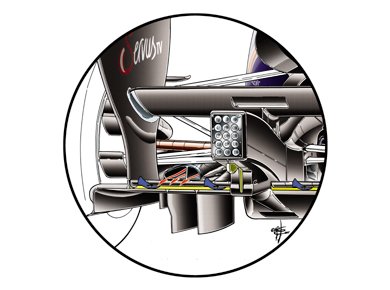 
Red Bull brought to Istanbul a more sophisticated version of their exhaust, which better integrates with the car's side diffuser. But the new solution was destroyed when Sebastian Vettel slid off the track and into the barriers during Friday practice. So both Vettel and Mark Webber ran the team's more conventional solution (seen here) during qualifying and the race. It features a small horizontal flap (highlighted in yellow), originally introduced by Toro Rosso at the launch of their car (and subsequently tested by Ferrari on Friday), designed to improve cohesion between the air flowing from the exhausts (red arrows) and from the rear diffuser (blue arrows).
[859] 08 May 2011 - Renault R31 - revised front wing
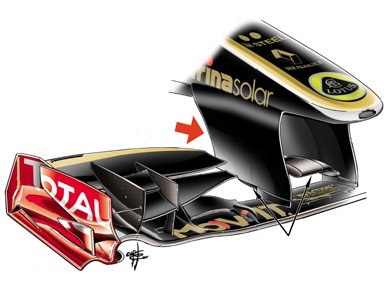 
Renault came to Istanbul with a front-wing solution similar to Ferrari's in that it has much longer central pillars, with the cameras mounted on the inside. The rest of the wing is largely similar to the team's previous solution.
[860] 21 May 2011 - Ferrari 150° Italia - banned rear wing
 
Ferrari ran this rear wing in Friday's practice sessions in Spain, but had to revert back to their Turkey-spec design from Saturday onwards after the FIA deemed it illegal. The area of controversy was the additional Gurney flaps on the top (in yellow), which took the wing 30mm over the normal maximum height limit. That limit is 950mm above the reference plane (the lowest part of the car, excepting the plank), the same as for the engine cover and roll-over structure. Ferrari claimed the flaps were not actually not part of the wing, but were actually part of the slot-gap separator, or rear wing supports, which are exempt from the height requirement. The FIA disagreed and decided that the configuration breached article 3.10.3 of the technical regulations. Charlie Whiting conceded that it was a clever interpretation, but felt it was not within the spirit of the rules.
FIA Technical Regulations, Article 3.10.3:
In order to ensure that the individual profiles and the relationship between these two sections can only change whilst the car is in motion in accordance with Article 3.18, they must be bridged by means of pairs of rigid impervious supports arranged such that no part of the trailing edge of the forward section may be more than 200mm laterally from a pair of supports. These pairs of supports must :
- be located no more than 355mm from the car centre line ;
- fully enclose each complete sections such that their inner profiles match that of each section. With the exception of minimal local changes where the two sections are adjacent to each other, their outer profiles must be offset from the inner profiles by between 8mm and 30mm and may not incorporate any radius smaller than 10mm ('gurney' type trim tabs may however be fitted between the supports) ;
- be aligned as a pair so as to provide a bearing across their full thickness and along a profile length of at least 10mm when the distance between the two sections is at its closest position ;
- not be recessed into the wing profiles (where a recess is defined as a reduction in section at a rate greater than 45° with respect to a lateral axis) ;
- be arranged so that any curvature occurs only in a horizontal plane ;- be between 2mm and 5mm thick ;
- be rigidly fixed to their respective sections ;
- be constructed from a material with modulus greater than 50GPa.
These supports will be ignored when assessing whether the car is in compliance with Articles 3.6, 3.9.2, 3.10.1, 3.10.2, 3.10.4 and 3.10.6.
[861] 21 May 2011 - Force India VJM04 - revised nose and front wing
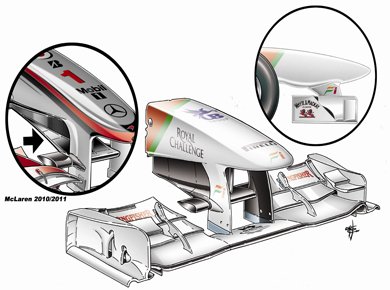 
Force India have brought to Spain the new nose and front wing they introduced at the last round in Istanbul (main picture). Very different to the bulkier one used previously (right-hand inset), the new solution has a Red Bull-inspired nose section and features aero devices on its underside similar to those introduced by Williams two years ago and used by McLaren in 2010 and this year (left-hand inset). Other new components to look out for are the revised endplates and the three wing elements. In the end, however, the team opted to use the previous standard wing configuration for qualifying and the race. They also tested Red Bull-style exhausts on Friday, but again decided not to run the solution on Saturday and Sunday.
[862] 21 May 2011 - Mercedes MGP W02 - modified bodywork
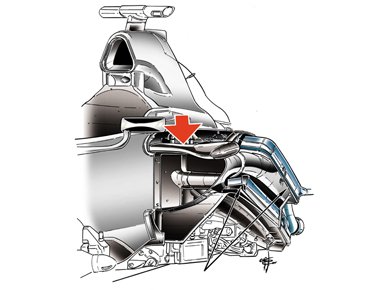 
Mercedes have brought new bodywork to Spain, including slightly different deformable side structures (red arrow), necessitating a further FIA side crash test. There is also a revised radiator installation (black arrows), although the double floor layout (currently unique in Formula One), has been retained. The team have also modified the car's rear suspension geometry.
[863] 21 May 2011 - McLaren MP4-26 - revised sidepods
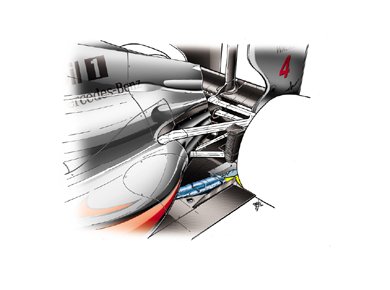 
McLaren have brought a massive upgrade to Spain. There's a new gearbox and rear suspension, a new front wing design, plus new sidepods and a modified exhaust/diffuser layout. Here is seen the longer version of the sidepods, which the team tested on Friday. They opted to remove the final section of the sidepods for qualifying and the race.
[864] 28 May 2011 - Ferrari 150° Italia - modified engine cover
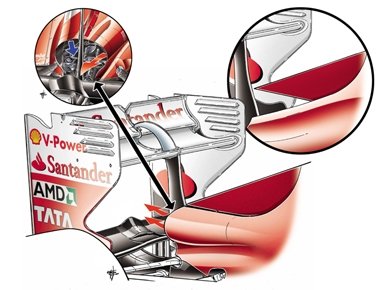 
With just a week between the Spanish and Monaco rounds, it was a surprise to see a new engine cover on the Ferrari in Monte Carlo (main picture), but a closer inspection reveals it isn't an entirely new solution. The Italian team developed it for the Malaysian event back in April, but didn't run it in the Sepang race because the cooler-than-expected weather conditions rendered it unnecessary. The large hole at the back (left-hand inset) through which hot air is evacuated allows a glimpse of the car's rear suspension. The solution is very similar, though perhaps not quite as clean, as the one seen on the Red Bull. The change means that the base of the engine cover and upper 'shark fin' now converge, unlike on the previous version (right-hand inset).
[865] 28 May 2011 - Ferrari 150° Italia - revised front wing
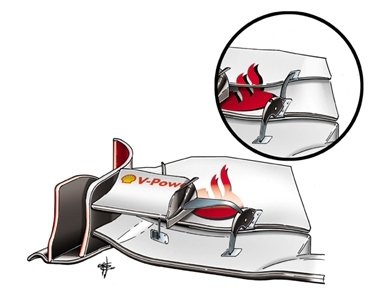 
Ferrari introduced a new front wing at the Turkish round and updated it for last weekend's Spanish race. In Monaco another revision has been made to the wing (main picture), with a single flap replacing the two-section version (inset). This is designed to boost downforce at slow speeds around the narrow and tricky Monte Carlo streets. The 150° Italia's rear wing, meanwhile, features no updates, with the team using the same version seen at the car's launch and during pre-season testing.
[866] 29 May 2011 - McLaren MP4-26 - front wing updates
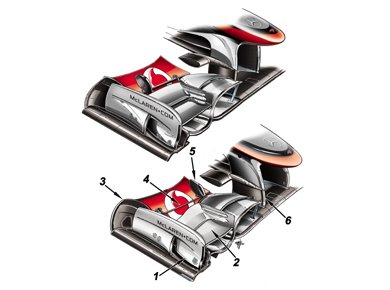 
For Monaco, McLaren have kept the all-new front wing assembly (lower drawing) introduced in Spain. All the components are different to the team's previous solution (upper drawing). The outer-front edge of the endplate (1) is slightly shorter and lower, while the inside-rear section (3) has been extended. New upper flaps (2) are more curved than before and the rear part of the main plane (4) has been modified beside the endplate. The faring for the adjustment mechanism (5) has been moved inwards to increase its aerodynamic influence and help channel airflow to the sidepods. The new wing pillars (6) are now angled forward, converging slightly, and are attached differently to the main plane.
[867] 29 May 2011 - Toro Rosso STR6 - new rear wing
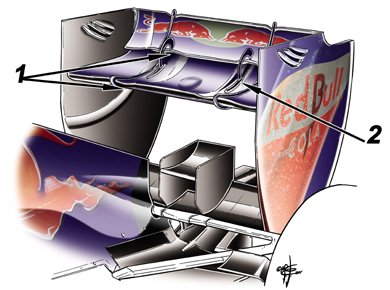 
Toro Rosso are the only team to bring a completely new rear wing with them to Monaco. The wing has quite a complex shape and features a curved section on its main plane and flap (1). The adjustment (2) of the car's Drag Reduction System (DRS) is activated at two points. Also important to note is the small lower wing placed on top of the beam wing. This is only 15cm wide, so fits within the regulations.
[868] 29 May 2011 - Mercedes MGP W02 - revised cooling solution
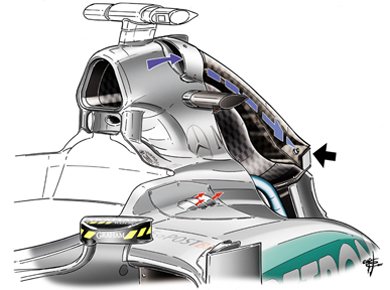 
To improve their car's cooling in Monaco, Mercedes have simply adopted the 'ears' solution on the side of the airbox (uppermost purple arrow), as seen from launch on the McLaren MP4-26. It sends air to the oil radiators (black arrow) for the gearbox and KERS in a dedicated channel, separate to the one for the engine manifold.
[869] 11 June 2011 - Mercedes MGP W02 - revised rear suspension
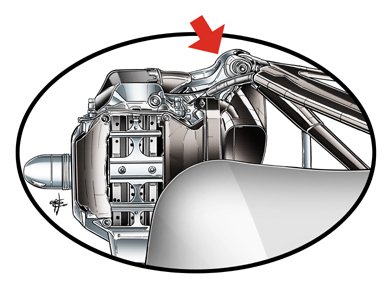 
In Montreal Mercedes are evaluating a revised rear suspension set-up. The pick-up point (red arrow) between the top wishbone and the upright is higher and further inboard than before, in order to give a lower roll centre and better camber change. The team ran a comparative test during Friday practice and, if the data compares well, they plan to run the revision in the next few races.
[870] 11 June 2011 - Ferrari 150° Italia - Montreal-spec brakes
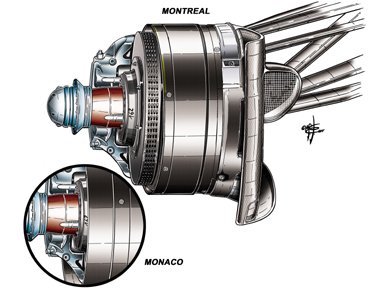 
Montreal is one of the hardest tracks on the calendar for brakes. All the teams have brought special ducts to improve cooling and have used more durable carbon discs. Ferrari have followed McLaren's solution and also cut back the aerodynamic drum around the brake. They ran something similar in Monaco (see inset), but here the disc (a Montreal-specific one made by Brembo at Ferrari's suggestion) is almost completely exposed (main image).
[871] 11 June 2011 - McLaren MP4-26 - Montreal-spec brakes
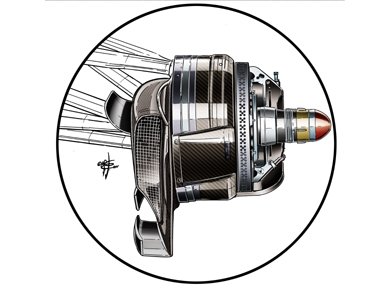 
The Montreal circuit is so demanding on brakes that all of the teams bring more hard-wearing discs and special ducts to improve cooling. Although McLaren are using the same discs they used in Monaco, they feature very different, cross-shaped openings to better dissipate the huge amount of heat that is generated on the Canadian circuit.
[872] 12 June 2011 - Williams FW30 - low-downforce rear wing
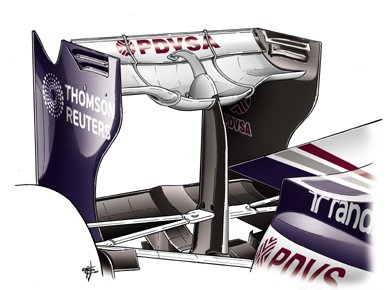 
Along with Renault, Williams were the only team in Montreal to test an extreme low-downforce rear wing on Friday, but then not use it for qualifying and the race. Their design had a spoon shape in the central section to increase downforce.
[873] 12 June 2011 - Renault R31 - low-downforce rear wing
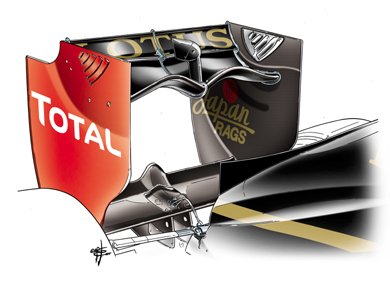 
Like Williams, Renault tested an extreme low-downforce rear wing on Friday in Montreal, but then opted not use it for qualifying and the race. Their heavily-sculpted design was an evolution of one tested but not raced in 2010.
[874] 25 June 2011 - Ferrari 150° Italia - revised rear suspension
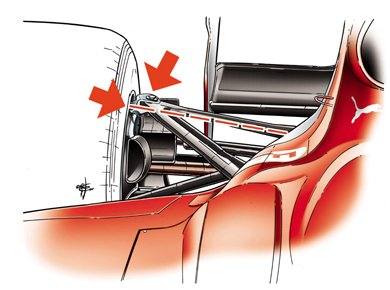 
In Valencia practice, Fernando Alonso again tried the new rear suspension introduced in Montreal, with the aim of collecting more data ahead of its planned introduction as part of a major update for Silverstone. This set-up features a higher pick-up point between top wishbone and upright, giving a lower roll centre and better camber change.
[875] 25 June 2011 - Red Bull RB7 - revised underbody aero package
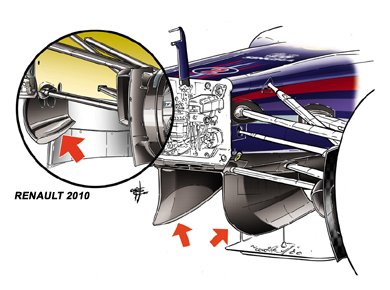 
Mark Webber tested a new aero package for Red Bull on Friday in Valencia. The evaluation went so well that both drivers used it for qualifying and the race. The nosecone no longer features any fins in its lower section as they have been transferred to the underbody of the chassis (main drawing). A similar solution was introduced by Renault last year (inset) and was retained on this year's R31.
[876] 26 June 2011 - McLaren MP4-26 - new front wing
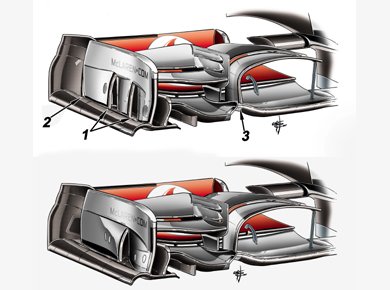 
McLaren have brought a new front wing to Valencia, based on the one they introduced at the Spanish race back in May. The new version (top drawing) features a different endplate with two vertical, external openings (1). Also visible is a third vertical slot (2) positioned on the inside of the endplate. Another feature to note is the upper flaps (3), which are shaped differently and mounted closer to the nose than before. Both Jenson Button and Lewis Hamilton used this new front wing in the European race after running a back-to-back test with the old one on Friday.
[877] 26 June 2011 - Toro Rosso STR6 - new exhaust
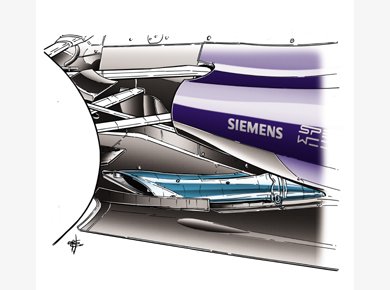 
The Toro Rosso has undergone a lot of changes ahead of the European round. There are different sidepods, which are taller, and different radiators. There are also new exhausts, which are no longer unique in shape but similar to the ones on the Red Bull, with a long and flat section in front of the rear tyres.
[878] 09 July 2011 - Mercedes MGP W02 - revised exhausts & diffuser
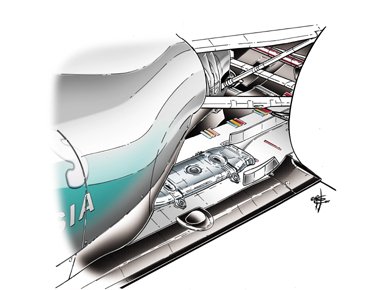 
All weekend at Silverstone, Mercedes have been using this new, longer exhaust design (similar to that on the Red Bull, McLaren, Ferrari and others), which was seen but never used at the last round in Valencia. It sees the team move away from the configuration they had been using since pre-season testing, with the exhaust exits further forward, in the middle of the sidepod. Also totally new is the rear diffuser, a large section of which is now protected by heat-resistant material in light of the revised exhaust layout.
[879] 09 July 2011 - Ferrari 150° Italia - revised exhaust layout
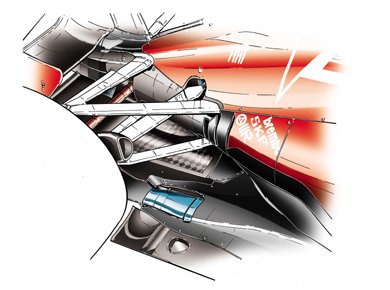 
Ferrari introduced a new aero package for Great Britain, together with the new rear suspension layout previously tested in Friday's sessions in Canada and Valencia. On Friday at Silverstone Massa tried out this new exhaust layout, complete with longer sidepods featuring three vertical cooling gills to dissipate heat, and an extension on top of the new rear diffuser to improve airflow. Both cars run the updates on Saturday morning.
[880] 09 July 2011 - Ferrari 150° Italia - revised rear wing
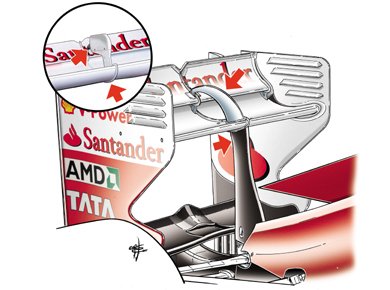 
As part of Ferrari's new aero package for Silverstone, Alonso tried out this new rear wing on Friday, featuring a new DRS control system. Gone is the hydraulic linkage inside a central pillar (main drawing), replaced instead by an electric motor (inset) as used by Red Bull, Renault, Force India and Toro Rosso. Both cars run the update on Saturday morning.
[881] 10 July 2011 - McLaren MP4-26 - revised rear wing
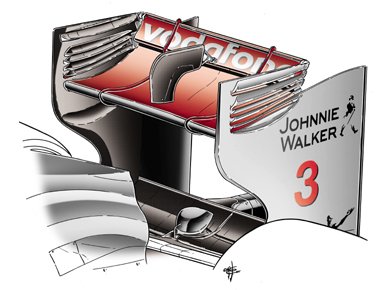 
At Silverstone McLaren introduced a new rear wing that features a smaller chord for the flap, with the DRS activated by an electric motor like that used by Red Bull, Renault, Force India and - for Silverstone - Ferrari. However, a back-to-back comparison between the new and old designs on Jenson Button's car in practice convinced the team to drop the new version for qualifying and the race.
[882] 10 July 2011 - Williams FW33 - revised front wing
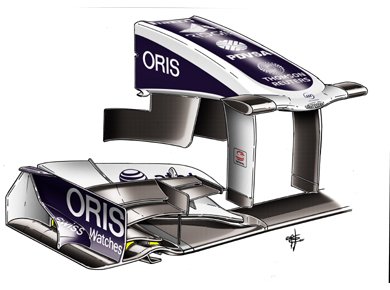 
As well as using longer exhausts on both cars like Red Bull, Williams brought a new front wing to Silverstone which they used on both cars during qualifying and the race. Although the main profile is similar to the previous one, the endplates have been changed significantly for the British round.
[883] 23 July 2011 - Mercedes MGP W02 - revised front wing
 
Mercedes have introduced a new front wing at the German event. Similar in style to the one on Red Bull's RB7, the new front wing (see main drawing) features double upper-deck flaps (see red arrow) and is designed to improve the car's aerodynamic balance and corner entry. It has been used by both Michael Schumacher and Nico Rosberg at the Nurburgring. The old style front wing can be seen in the inset.
[884] 23 July 2011 - McLaren MP4-26 - brake duct experiments
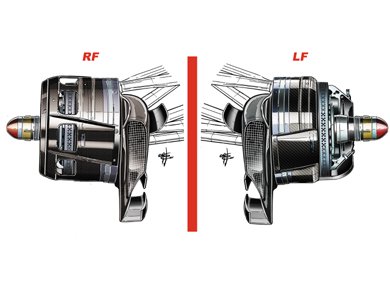 
McLaren experimented a lot during practice at the Nurburgring to try and find brake feeling to Lewis Hamiltons liking. Hamilton, who tends to brake very late into corners, started the weekend using discs from Carbon Industries and asymmetric brake ducts, fully open on the left (LF) and partially enclosed (by a drum with rectangular cuts) on the right (RF). During qualifying Hamilton opted to use the open version but with Brembo discs, which team mate Jenson Button had used in the morning practice session. The team also added some corner weight to his car during the Friday and Saturday morning practice sessions in an effort to sort out the instability problem he experienced under heavy braking.
[885] 24 July 2011 - Renault R31 - rearward exhaust
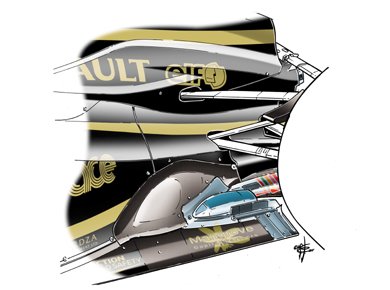 
Renault tested a prototype 'Red Bull-style' rearward exhaust on Nick Heidfeld's car on Friday in Germany (see blue highlighted area and red arrow). However, as the R31 has been built around a unique forward-facing exhaust layout, the team's trial was limited to assessing the system's potential for the future, rather than evaluating it for the Nurburgring event. The car's bodywork, especially in the area in front of the rear tyres, is too wide to fully exploit the benefits of a rear-facing exhaust. After the summer break we should see a heavily updated R31 featuring new sidepods and exhausts.
[886] 24 July 2011 - Ferrari 150° Italia - revised brake ducts
 
Ferrari have followed a pit lane trend by adding a cascade of small flaps on the inside of the brake duct (see black arrows) in an area where the rules permit teams to gain some rear downforce. The solution was first used by Williams and Sauber last year.
30 July 2011 - Ferrari 150° Italia - front wing updates
 
Ferrari tried a lot of new components in Hungary on Friday, even some aero solutions that could be useful on the 2012 car, which will have a differently shaped cockpit. Both Fernando Alonso and Felipe Massa tested this front wing (main drawing), which (in Red Bull style) features an additional upper-deck flap absent on the regular configuration (inset).
30 July 2011 - Ferrari 150° Italia - rear wing updates
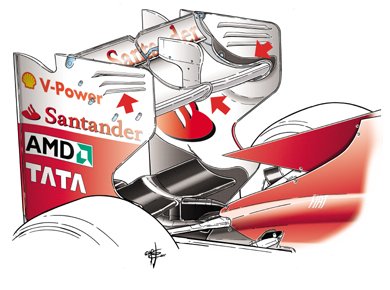 
Ferrari tried a lot of new components in Hungary on Friday, even some aero solutions that could be useful on the 2012 car, which will have a differently shaped cockpit. Both Fernando Alonso and Felipe Massa trialled this rear wing in a back-to-back test with the configuration used previously for qualifying and the race in Germany. It has a curved main plane (centre red arrow), where the previous one was straight, with only three gills in the endplate (left red arrow), and different positioning of the planes relative to the endplate (right red arrow). These endplates seem to be in Spa configuration, but with, of course, a different, medium-downforce main plane and flap set-up.
30 July 2011 - Renault R31 - front wing variations
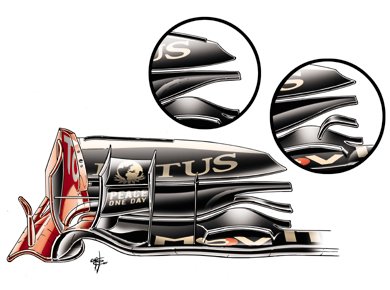 
Renault's drivers had three different front wings at their disposal on Friday in Hungary, including one used by the team in Monaco (left circle). In the end they chose the one shown in the main drawing for qualifying and the race. This configuration was also used at the Nurburgring last weekend.
31 July 2011 - Red Bull RB7 - front wing changes
 
Red Bull used a mix of old and new front-wing solutions in Hungary. They moved back to the original, thin wing support, in place of the newer, wide one (1), and also reverted to the turning vanes under the nose cone (2) rather than those attached to the lower part of the chassis which the team had been running since Valencia. The main plane and flap (3) were new, derived from the Nurburgring configuration, and on Friday Sebastian Vettel also tried a different flap design (4) for a few laps.
27 August 2011 - McLaren MP4-26 - brake duct aero development
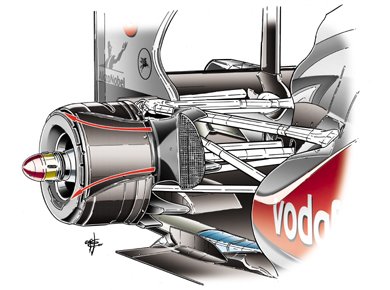 
Brake ducts are ever evolving and becoming increasingly important as aerodynamic devices. As well as attaching aero fins to the inside, teams - including McLaren - have started to mimic the effect of the wheel rim covers seen in previous seasons (but now banned) with complex-shaped brake ducts which better control the flow of air around the outside of the wheel. This drawing shows the rear brake drum on the MP4-26.
27 August 2011 - Ferrari 150° Italia - front wing variations
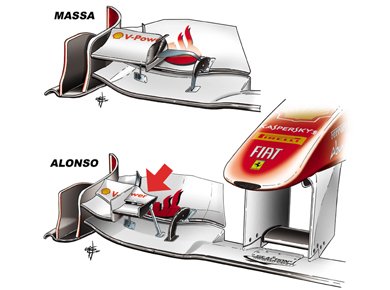 
Ferrari have opted to use two different front wings for the qualifying session and race in Belgium. Massa decided to stay with the one he used in Canada, whilst Alonso is running with a new version. Tested in Hungary, it features Red Bull-inspired upper flaps (red arrow), and a single main flap instead of the previous double solution.
27 August 2011 - Mercedes MGP W02 - revised front wing
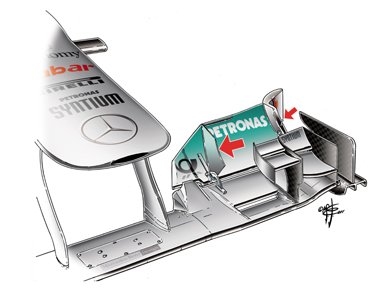 
Mercedes have brought another evolution of the front wing they introduced in Hungary to Spa. As well as the additional upper flap, which was inspired by the Red Bull, there is now an additional vertical fin (large red arrow) to better direct airflow. The team have also modified the system used to adjust the flap's angle of incidence by moving it from its previous central position (where the new fin now is) to the side of the endplate (small red arrow).
28 August 2011 - Toro Rosso STR6 - new nose design
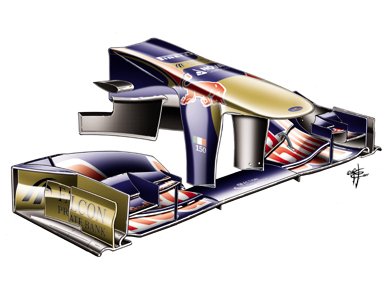 
Toro Rosso brought a brand new nose to Belgium. Taller, flatter and longer than before, it's similar to that used by Mercedes and will improve airflow in the car's lower sections. It passed its required crash test on August 4.
28 August 2011 - Red Bull RB7 - brake duct development
 
Red Bull brought two different rear brake duct solutions to Belgium. This one was used by Sebastian Vettel. It has a sophisticated shape behind the brake disc, similar to that used by McLaren, to better channel air to the outside of the wheel rim.
10 September 2011 - McLaren MP4-26 - rear wing
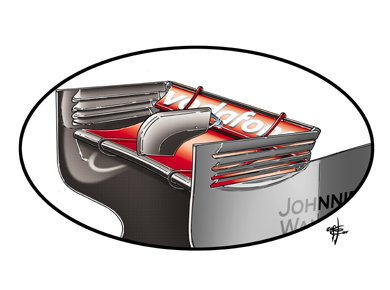 
In Italy McLaren are using the same rear wing they introduced in Spa. It is a touch more angled than those found on other cars, but seems to be advantageous in terms of grip into and out of corners and in braking areas, which in turn helps to conserve tyres.
10 September 2011 - Mercedes MGP W02 - rear wing
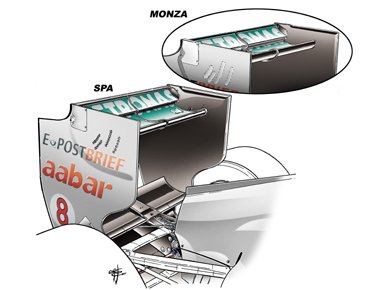 
In Italy (see inset) Mercedes are using the same rear wing they took to the last round in Belgium (see main drawing). However, to help achieve higher top speeds on Monza's long straights they have opted to use a different angle of incidence for the main plane, which now has a higher leading edge, and the flap, which is now angled much lower.
10 September 2011 - Toro Rosso STR6 - revised front wing
 
At the last round in Belgium Toro Rosso brought a new nose and in Monza they have tested a new front wing. It features a new small flap (see red arrow) to better direct the flow of air to the back of the car. The team evaluated the new wing on Friday but didn't opt to use it in qualifying and the race.
10 September 2011 - Ferrari 150° Italia - modified rear wing
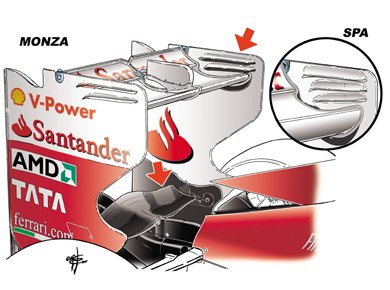 
In Monza Fernando Alonso and Felipe Massa have been using the new rear wing Ferrari introduced at the last round at Spa. But there are some differences on the Monza-spec wing (see main drawing), including different endplates with just two gills instead of three (see upper red arrow and inset) and a lower downforce main profile and flap. The beam wing (see lower red arrow) is also new. No longer straight in shape, it's wider at its centre and has a different chord. In order to produce more downforce and better preserve their tyres, Ferrari used slightly different incidence angles on the rear wing for qualifying and race compared to practice.
24 September 2011 - Red Bull RB7 - revised brake ducts
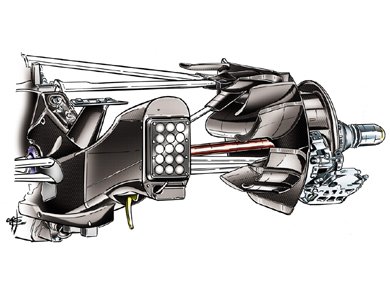 
At the rear of cars, brake ducts have become more and more important as downforce-boosting aerodynamic devices. The Red Bull ducts feature several small planes on the inside of the brake drum to help enhance downforce.
24 September 2011 - McLaren MP4-26 - new exhaust layout
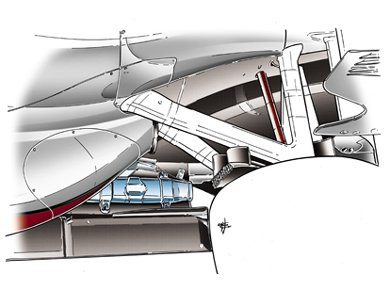 
McLaren are using a new exhaust layout in Singapore. Longer than the previous version, it has been combined with a new diffuser featuring a small, Red Bull-inspired flap in its central section.
24 September 2011 - Red Bull RB7 - revised front wing
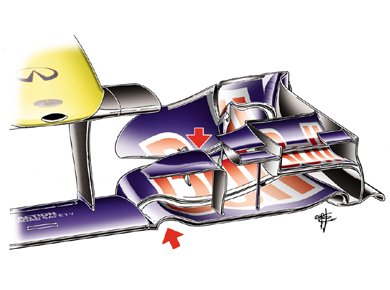 
Red Bull evaluated three different front wings in Singapore on Friday. Pictured is the one tested by Vettel and then used by both drivers during qualifying and for the race. There is a step on the main plane (left-hand arrow). This is similar in style to the solution introduced (but not raced) by McLaren in Spa. There is also a new upper flap (right-hand arrow), inspired by the one McLaren used in Monza.
25 September 2011 - Ferrari 150° Italia - modified exhaust
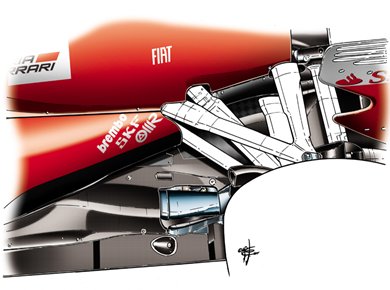 
In Singapore Ferrari have modified their exhaust layout. The final section (see blue highlighted area) is a little narrower than before and no longer features the small stepped section which helped to blow air both under and on the top of the side channel.
08 October 2011 - Red Bull RB7 - tyre warming strategy
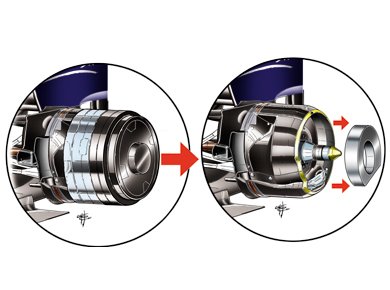 
Red Bull have devised a clever way to maintain tyre temperatures in the garage. The FIA long ago banned systems designed to do this by heating the inside of the wheel rim, as introduced by Toyota in Canada 2005. Since Belgium this year, however, Red Bull have been placing a small, pre-heated aluminium cylinder (right) inside all four brake ducts, an idea tested by Williams some years ago. The cylinder's primary function is to heat up the brake discs, but it also stops cold discs and callipers from robbing the blanketed tyres of valuable temperature. Just before the car leaves the garage mechanics wearing special gloves remove the rudimentary brake duct covers (left) and take out the cylinders.
09 October 2011 - McLaren MP4-26 - rear wing updates
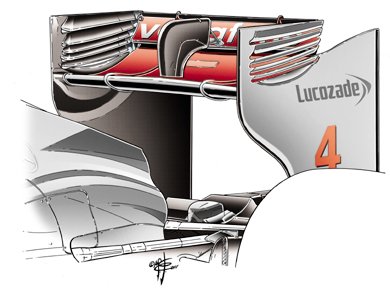 
At Suzuka McLaren introduced at least the fourth edition of the new DRS rear wing first seen at Silverstone. Compared the last update in Singapore, it has a more efficient DRS phase, with a greater reduction in drag, following the trend set by Red Bull and Ferrari.
09 October 2011 - Red Bull RB7 - front wing update
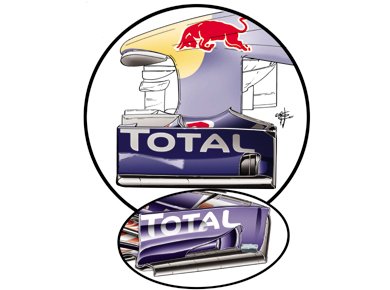 
At Suzuka Red Bull introduced another new front wing with an endplate comprising only two pieces. Unfortunately Vettel destroyed his in his Friday morning practice crash and the team decided to run with the old wing (lower drawing) on both cars until new spares could be flown out from the factory, arriving by helicopter just 20 minutes before qualifying.
15 October 2011 - Ferrari 150° Italia - new front wing
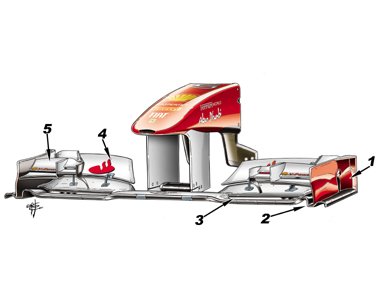 
Ferrari have brought a completely new front wing to Korea. It's understood it was initially being evaluated with 2012 in mind, but the team decided to run it on Fernando Alonso's car during qualifying and the race. There are many changes over the older version with most components (nosecone and wing pillars aside) radically different. The endplates (1) are very similar in style to the ones Red Bull introduced at Suzuka and no longer feature a secondary outside vertical fin. The main plane (2) is also reminiscent of the Red Bull with its middle slot (3), as is the large flap (4). The upper-deck flap (5), meanwhile, bears a similarity to the one found on the previous wing, introduced in Budapest back in July.
15 October 2011 - Sauber C30 - new front wing
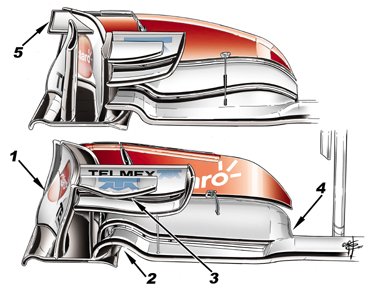 
In Korea, Sauber are using the new front wing they introduced in Japan last weekend (see bottom drawing). It features a new endplate (1) which is similar in style to Williams' solution. The attachment between the main profile and the end plate is also different with a curved section (2) whilst the profile and flap are much straighter (4) in style. The upper deck flaps (3) are completely different with a wider and more curved design, whilst the small outside fin found on the previous wing (see top drawing - 5) has been removed.
16 October 2011 - Toro Rosso STR6 - exhaust modifications
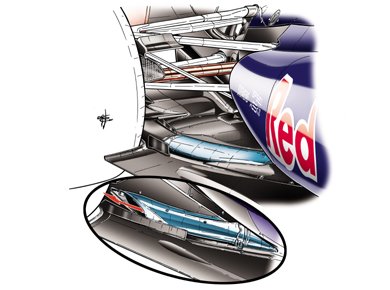 
On Friday in Korea Toro Rosso again tried new Red Bull-style exhausts, with a straight exit to the side channel of the diffuser. However, the team ultimately decided to run the standard, side-blowing solution (inset) for qualifying and the race. The Faenza team also retained the new front wing they introduced at Suzuka.
29 October 2011 - Renault R31 - revised rear bodywork
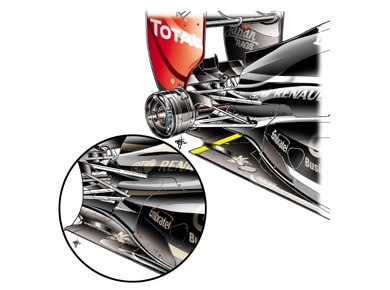 
Renault have returned to their standard rear bodywork (inset) for the Indian race. Compared to the narrower configuration, which features a more pronounced 'cola bottle' shape (see how the yellow highlighted area shows the wider area of floor it exposes), the cooling benefits of this wider bodywork outweigh the loss of aerodynamic performance it brings.
29 October 2011 - McLaren MP4-26 - new front wing
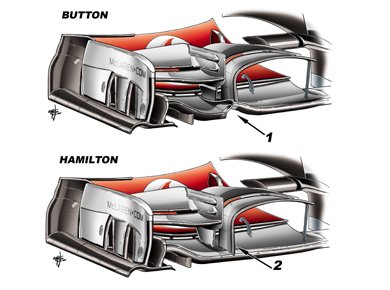 
McLaren have brought a new front wing to India. Drivers Jenson Button and Lewis Hamilton completed back-to-back comparisons on Friday and Hamilton eventually used the new version (see lower drawing) during qualifying and the race. Button, meanwhile, used the old version (see upper drawing). The new front wing has a straight main profile (2) and no longer features the indentation which divided the airflow under the car (1). There are also different upper flap mountings, although both solutions are reminiscent of ones used in 2010 before the team introduced the stepped main profile.
29 October 2011 - Ferrari 150° Italia - new front wing
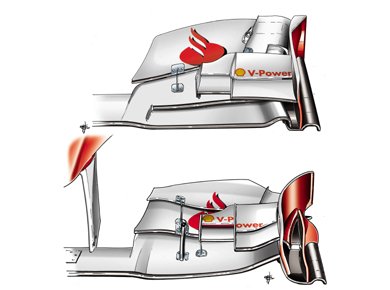 
In India both Ferrari drivers have been using the team's new, Red Bull-influenced front wing (upper drawing), which Fernando Alonso first sampled in Korea. Compared to the previous version (lower drawing), all components are different. There is now a single endplate, a slotted main plane with a different profile near the endplates, just one large flap and also different upper flaps. Ferrari brought three of the new front wings to New Delhi, so after Felipe Massa's qualifying accident the team have two left.
30 October 2011 - Mercedes MGP W02 - 'F-duct ' front wing
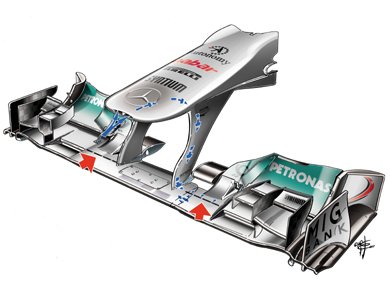 
2012 has well and truly started for Mercedes after the team briefly tested this innovative solution at Suzuka, prompting much discussion over its possible merits in India. Inspired by F-ducts, which were used extensively last season but were outlawed this year, Mercedes have switched the theory from the rear to the front of the car. The little oval hole, which is common in all the nose cones, features a splitter in the middle, thought to direct the airflow through the side pillars of the wing (blue arrows). Mercedes used a similar layout last year with its F-duct, which had little pipes going through the diffuser and the wing endplates. No opening was visible on the flaps, like in the rear wing last year, so the only possible opening was in underside of the main plane section (red arrows). In order for this system to be legal, unlike last year's F-ducts the driver must have no direct control over it, so it must instead be regulated by an amplifier inside the nose cone, coming into effect and stalling the wing to cut drag only under certain airflow conditions. Speculation continues over the exact workings of this Mercedes solution, but the important thing is that it again highlights the ability of F1 engineers to find loopholes in the rules and to produce innovative solutions.
12 November 2011 - Ferrari 150° Italia - revised front wing
 
On Friday afternoon in Abu Dhabi, Ferrari added an additional carbon skin on the pivoting point of their new Red Bull-style front wing on Felipe Massa's car (red arrow). The solution, however, failed to stop the wing from fluttering dramatically at certain speeds so the team decided to revert back to the standard front wing for the Brazilian. Fernando Alonso kept the new solution, but with a stiffer construction.
12 November 2011 - Red Bull RB7 - rearward exhaust
 
The Abu Dhabi race will be the penultimate time long exhausts can be used to blow air into the side channel of a car's rear diffuser to boost downforce. The Red Bull solution can be seen in the drawing. Next season blown diffusers will be banned, with exhaust exits having to be positioned periscope style atop the rear bodywork.
12 November 2011 - Red Bull RB7 - brake ducts and calipers
 
Yas Marina is a tough circuit on brakes so Red Bull have kept their drum ducts, complete with ventilation fins on the outside, on the RB7s. In the drawing you can also see the distinctively low placement of the brake calipers. These are supplied by Brembo to both Red Bull and Toro Rosso and their positioning lowers the suspension's centre of gravity.
13 November 2011 - Renault R31 - new front wing
 
In Abu Dhabi, Renault finally introduced this new, Red Bull-inspired front wing, which had been expected to appear at Suzuka last month. Run solely by Vitaly Petrov, the more flexible design differs from the previous version in several ways and is intended to boost downforce. The main plane has a different shape with a smaller chord, and the attachment to the central section is also different (lower arrow). The curved flap (upper arrow) is similar in shape and length to that found on the Red Bull.
© 2011 Formula One World Championship Ltd
|